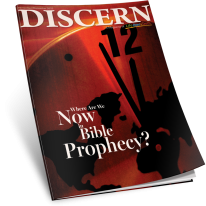God did not finish His creative work in the Garden of Eden. Many know the beginning, but few know God’s plan for completing His creation!

We read in Genesis 1:26, “Then God said, ‘Let Us make man in Our image, according to Our likeness.’” This concise statement tells us that the creation of this physical universe had a purpose, an endgame if you like. God planned for humanity to be made in His image! This means the creation was not completed when God made Adam and Eve.
Did this plan start millions of years ago with the slow evolution of humans from primitive animal types, or did God designate a finite length of time in which He would introduce, execute and finish His intended goal for humanity?
The Bible—the Word of God—can answer these questions and, in the process, give you a more complete picture of His goal and purpose for your life. Yes, God has a plan, and He wants to share that plan with you!
Time before Adam
Before God made man in His image, we are told, “In the beginning God created the heavens and the earth. The earth was without form, and void; and darkness was on the face of the deep. And the Spirit of God was hovering over the face of the waters” (Genesis 1:1-2, emphasis added throughout). The fossil record indicates that there have been living things on this planet for millions of years, but when did the creation of Adam and Eve occur?
The Bible does not reveal many details about the history of this planet before the creation of Adam and Eve. Clearly, humankind as we know it today is the focus both of Scripture and of God’s plan. Yet Scripture hints at a creation that existed before God made Adam and Eve. The earlier creation is hinted at in the statement above: “The earth was without form, and void.”
The planet was a disaster
The Hebrew word translated “without form” is tohu, and the word translated “void” is bohu. Tohu is “a masculine noun meaning formlessness, confusion” (Complete Word Study Dictionaries by Eugene E. Carpenter, Warren Baker and Spiros Zodhiates, 2003). Bohu means “a vacuity, i.e. (superficially) an indistinguishable ruin:—emptiness” (Enhanced Strong’s Dictionary, 2011).
In direct contrast to the disaster scene of Genesis 1:2, we read that the righteous angels of God shouted for joy at the beauty of the creation of the earth (Job 38:4-7). Surely, they did not shout for joy at the creation of an amorphous blob, which Genesis 1:2 describes! Confirming this, the prophet Isaiah was inspired to write that God did not create the earth “in vain” (Hebrew tohu, Isaiah 45:18).
So the concise history of the earth begins with an initial creation of the physical universe, then the explanation that our planet had become a disaster scene! To learn what happened between Genesis 1:1 and Genesis 1:2, see “God vs. Satan.”
The Bible deals mainly with the re-creation or reshaping of the earth for mankind and what happens thereafter. Since the Bible focuses upon God’s plan for mankind, instead of the earth before Eden, so should we. How long ago did God’s plan begin? And when will it end?
The weekly cycle
A closer look at the first chapter of Genesis gives us a very interesting timeline. Notice that God’s work with the physical creation lasted for six days, with the pinnacle of His work—the creation of the first humans—occurring on the sixth day: “Then God said, ‘Let Us make man in Our image, according to Our likeness. … Then God saw everything that He had made, and indeed it was very good. So the evening and the morning were the sixth day” (Genesis 1:26, 31).
For an explanation of why the Bible uses “Us” and “Our,” indicating that there is more than one member of the God family, see “God Is Good” and “Names of God.”
Human beings were created physical, and yet God’s clearly stated purpose is to also create them in His spiritual image.
Notice that there is a spiritual element to creation. The human beings were created physical, and yet God’s clearly stated purpose is to also create them in His spiritual image. Therefore, God’s creative work for humans was not finished or completed when God made Adam and Eve. The spiritual aspect involves a process that continues on beyond the creation of humans as physical beings.
Blessing the seventh day
Continuing in the account in Genesis, we see that there was still another thing that God had yet to do. “Thus the heavens and the earth, and all the host of them, were finished. And on the seventh day God ended His work which He had done, and He rested on the seventh day from all His work which He had done. Then God blessed the seventh day and sanctified it, because in it He rested from all His work which God had created and made” (Genesis 2:1-3).
On this day, God rested, not because He was tired, but rather to make the seventh day holy. The Sabbath should be used for rest and worship. It is a key element in creating humankind in God’s spiritual image.
Key concepts
In summary, here are two key concepts that we can learn from creation week:
- We humans should work for six days, and rest on the Sabbath, just as God did when He set us that wonderful example! (See our section on the “Sabbath” to find an explanation of this important biblical teaching.)
- The seven-day model of the week also seems to symbolize something deeper about God’s overall plan for humankind. Christ inspired the apostle Peter to help us understand how much differently God views time than the way humans do. “But, beloved, do not forget this one thing, that with the Lord one day is as a thousand years, and a thousand years as one day” (2 Peter 3:8).
It appears that God’s plan for humankind is symbolized by the weekly cycle. Humankind will go its way for six days (6,000 years as God looks at time). After that will come another day (another 1,000 years) that parallels the Sabbath.
A future Sabbath rest
Reading through Hebrews 4, we see an interesting meaning of the Sabbath emerge. “Therefore, since a promise remains of entering His rest, let us fear lest any of you seem to have come short of it. For indeed the gospel was preached to us as well as to them; but the word which they heard did not profit them, not being mixed with faith in those who heard it.
“For we who have believed do enter that rest, as He has said: ‘So I swore in My wrath, “They shall not enter My rest,”’ although the works were finished from the foundation of the world. [The work of physical creation was finished, but not the work of spiritual creation.]
“For He has spoken in a certain place of the seventh day in this way: ‘And God rested on the seventh day from all His works’; and again in this place: ‘They shall not enter My rest.’ Since therefore it remains that some must enter it, and those to whom it was first preached did not enter because of disobedience, again He designates a certain day, saying in David, ‘Today,’ after such a long time, as it has been said: ‘Today, if you will hear His voice, do not harden your hearts.’
“For if Joshua had given them rest [if God’s purpose had been completely fulfilled by bringing Israel to the Promised Land], then He would not afterward have spoken of another day.
“There remains therefore a rest for the people of God. For he who has entered His rest has himself also ceased from his works as God did from His” (Hebrews 4:1-10).
The Greek word translated “rest” in verse 9 is sabbatismos or “a keeping of a Sabbath” (Complete Word Study Dictionaries). Be aware of the fact that the authors of some Bible aids will insert their personal interpretations in commenting on this verse. Some try to explain it as going to heaven, but that misrepresents what Christ inspired to be written.
The correct translation shows that God’s people today will still be keeping the day He set aside at creation for rest and worship—the seventh day. For further study, see “Sabbatismos: Does Hebrews 4:9 Teach Rest on the Sabbath?”
When we carefully study Hebrews 4:1-10, we find references to three types of rest: (1) the seventh-day Sabbath, (2) the “rest” that Israel should have enjoyed in the Promised Land and (3) a future rest.
When will this future rest come about and how long will it last?
The millennial rest
“And I saw thrones, and they sat on them, and judgment was committed to them. Then I saw the souls of those who had been beheaded for their witness to Jesus and for the word of God, who had not worshiped the beast or his image, and had not received his mark on their foreheads or on their hands. And they lived and reigned with Christ for a thousand years” (Revelation 20:4).
Can you see this picture more clearly now? “Millennium” comes to the English language from a Latin word meaning 1,000 years. Following 6,000 years of humanity doing its own works, people will be brought under the government of God. This will mean true peace—rest—for the first time in human history. Christ will share His throne with the resurrected saints who will assist in bringing rest to a weary world.
This 1,000-year period of time is symbolized by the Sabbath. It represents a major step in God’s plan to complete the creation of humankind in His image.
God did not need six days
Obviously, the omnipotent God did not need six days to re-create the earth and populate it with animals and humans. He took six days to do this work, apparently to symbolize that He would give humankind 6,000 years to pursue every imaginable form of government, religion and culture—time enough to demonstrate that humans apart from God will never have true rest.
We don’t know the precise date of Adam and Eve’s creation, but adding together the chronology found in the Bible, it is clear that they were created approximately 6,000 years ago.
This means the time of Christ’s return and the establishment of the millennial rest is approaching. Part of God’s plan in setting aside the seventh day of creation as a spiritual rest day was to symbolize the millennial rest, by which God will bring millions or perhaps billions of human beings into His spiritual family.
Looking for the church behind Life, Hope & Truth? See our “Who We Are” page.
A lingering question remains
But what will happen to everyone who died without understanding God’s plan? We know that salvation (which is complete when God changes believers to spirit—the full image of God) is impossible apart from Christ (Acts 4:12). We also know that millions have died without ever having heard the name of Christ, much less receiving God’s invitation to be made in His image. Moreover, it is not God’s will to lose anyone (2 Peter 3:9).
How can the rest be saved?
For the rest of this amazing story, see “Second Resurrection: A Second Chance?” Many people who have read the Bible all their lives have not noticed this amazing truth. You need to understand this exciting and comforting truth that is the last step in God’s revealed plan.





